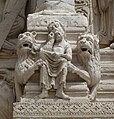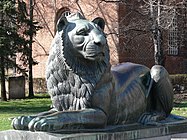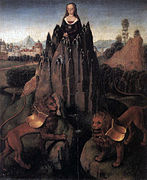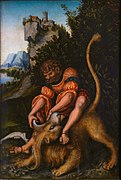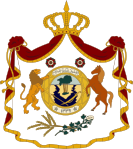Cultural depictions of lions
The
The earliest historical records in Egypt present an established religious
Depictions of lions in other cultures resembled this and all changed into more supportive roles as human figures began to be portrayed as deities. Similar imagery persisted and was retained through cultural changes, sometimes unchanged. Adoptions of lion imagery as symbols into other cultures without direct contact with lions could be very imaginative, often lacking accurate anatomical details or creating unrealistic characteristics. The association of lions with virtues and character traits was adopted in cultures where and when the religious symbolism had ceased.
History and mythology
First depictions
The earliest known
Europe
A bronze statue of a lion from either southern Italy or southern Spain, from c. 1000–1200 years CE was put on display at the Louvre Abu Dhabi.[4]
Ancient Egypt
The earliest tomb paintings in
Similar regional lioness deities assumed minor roles in the pantheon or, when so significant in a region, continued local religious observance in their own right, such as
During the
The sphinx of Ancient Egypt shows the head and shoulders of a human and the body of a lioness. The statues represents Sekhmet, who was the protector of the pharaohs. Later pharaohs were depicted as sphinxes, being thought as the offspring of the deity.[citation needed]
Ancient Mesopotamia

In ancient
Sculptures and reliefs of the
Ancient sculptures
Lions have been widely used in sculpture to provide a sense of majesty and awe, especially on public buildings. Lions were bold creatures and many ancient cities would have an abundance of lion sculptures to show strength in numbers as well.[12][13] This usage dates back to the origin of civilization.[14] There are lions at the entrances of cities and sacred sites from Mesopotamian cultures; notable examples include the Lion Gate of ancient Mycenae in Greece that has two lionesses flanking a column that represents a deity,[15] and the gates in the walls of the Hittite city of Bogazköy, Turkey.[13]
Iran
Lions are depicted on vases dating to about 2600
Lions have been extensively used in ancient Persia as sculptures and on the walls of palaces, in fire temples, tombs, on dishes and jewellery; especially during the Achaemenid Empire. The gates were adorned with lions.[18]
Classical period
Several discoveries of lion bones in Greece, Ukraine and the Balkans have confirmed that lions lived there certainly from 5th millennium BC until the 6th century BC, while according to the written sources they survived up to perhaps the 1st or even the 4th century AD, which was previously only a suspicion by some archaeologists.[19][20][21][22][23][24] Thus the strong emphasis on lions in the earliest figurative Greek art, especially that of Mycenaean Greece from around 1600–1400 BC, reflected the world in which Greeks lived, rather than being based on stories from further east, as once thought.[25]
Lionesses often flanked the Gorgon, a vestige of the earliest Greek protective deity that often was featured atop temples of later eras. The western
This lion is also said to be represented by the
Since classical antiquity, a Gaetulian lion in literature is a lion of fierce reputation. Gaetulia, in ancient geography, was the land of the Gaetuli, a warlike tribe of ancient Libya that appears in Virgil's Aeneid (19 BC).[28] The Gaetulia lion appears in Odes of Horace (23 BC),[29] Pliny the Elder's Natural History (77 AD),[30] Philostratus's Life of Apollonius of Tyana (c. 215),[31] Robert Louis Stevenson's Travels with a Donkey in the Cévennes (1879).[32]
In Socrates' model of the psyche (as described by Plato), the bestial, selfish nature of humanity is described metaphorically as a lion, the "leontomorphic principle".[33]
Biblical references and Jewish-Christian tradition

Several Biblical accounts document the presence of lions, and cultural perception of them in ancient Israel. The best known Biblical account featuring lions comes from the Book of Daniel (chapter 6), where Daniel is thrown into a den of lions and miraculously survives.[citation needed]
A lesser known Biblical account features Samson who kills a lion with his bare hands, later sees bees nesting in its carcass, and poses a riddle based on this unusual incident to test the faithfulness of his fiancée (Judges 14). The prophet Amos said (Amos, 3, 8): "The lion hath roared, who will not fear? the Lord GOD hath spoken, who can but prophesy?", i.e., when the gift of prophecy comes upon a person, he has no choice but to speak out.[citation needed]
The lion is one of the living creatures in the Book of Ezekiel. They were represented in the tetramorph.
In 1 Peter 5:8, the Devil is compared to a roaring lion "seeking someone to devour."[34][35]
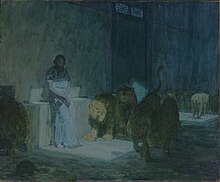
The lion is the biblical emblem of the
In Christian tradition, Mark the Evangelist, the author of the second gospel is symbolized by the lion of Saint Mark – a figure of courage and monarchy. It also represents Jesus' Resurrection (because lions were believed to sleep with open eyes, a comparison with Christ in the tomb), and Christ as king. Some Christian legends refer to Saint Mark as "Saint Mark the Lionhearted". Legends say that he was fed to the lions and the animals refused to attack or eat him. Instead the lions slept at his feet, while he petted them. When the Romans saw this, they released him, spooked by the sight.
Christian tradition has associated lions with Christ's resurrection. In the Christian text Physiologus, lion cubs are said to be born stillborn and the mothers cares for them until the father returns on the third day to breathe life into them.[38]
Late antiquity mysticism
In Gnostic traditions, the Demiurge is depicted as a lion-faced figure ("leontoeides"). The gnostic concept of the Demiurge is usually that of a malevolent, petty creator of the physical realm, a false deity responsible for human misery and the gross matter than traps the spiritual essence of the soul, and thus an "animal-like" nature. As a lion-headed figure, the Demiurge is associated with devouring flames,[39] destroying the souls of humans after they die, as well as with arrogance and callousness.[40]
A lion-faced figurine is usually associated with the
- Reliefs and statues
-
Samson and the lions, Saint Trophime Church Portal (12th century)
-
A lion at the side of KingCathedral of Santiago de Compostela
-
AMazandaran, Iran.
-
A peaceful lion in Pietro da Cortona's depiction of the Golden Age
-
Gold embroidered lion on saddle pad from 1670 that belonged to King Charles XI of Sweden
-
The "Strength" card of theRider–Waite tarot deck
-
A Gnostic gem portraying a lion-faced deity
Arthurian legend
In a key scene of
- Sculptures of lions
-
Lion door handle at Burg Hohenzollern
-
One of the four lions inLandseer at the base of Nelson's Column
-
The Lion Monument in Lucerne, Switzerland, commemorates the sacrifice of the Swiss Guards at the Tuileries in 1792.
Islamic traditions
In both Arab and Persian culture, the lion is regarded as a symbol of courage, bravery, royalty and chivalry. The depiction of lions is derived from earlier
Dharmic traditions

The lion symbolism and its cultural depictions can be found in
South Asia
Neolithic cave paintings of lions were found in Bhimbetka rock shelters in central India, which are at least 30,000 years old.[52]
This article needs additional citations for verification. (October 2018) |

Narasimha ("man-lion") is described as the fourth incarnation (avatara) of the Hindu deity Vishnu in the Puranic texts of Hinduism, an anthropomorphic form assumed to slay a daitya (demon) named Hiranyakashipu.[53] A goddess corresponding to the appearance of Narasimha is also featured, called Narasimhi.[54]
Lions are also found in
The lion is symbolic for the Sinhalese, Sri Lanka's ethnic majority; the term derived from the Indo-Aryan Sinhala, meaning the "lion people" or "people with lion blood", while a sword-wielding lion is the central figure on the modern national flag of Sri Lanka. The entrance to Sigiriya, the Lion-Rock of Sri Lanka, was through the Lion Gate, the mouth of a stone lion. The paws of the lion is one of seven World Heritage Sites in Sri Lanka.[citation needed]
Southeast Asia

Lions were never native animals of Southeast Asia in recorded history. As the result, the depiction of lion in ancient Southeast Asian art, especially in ancient Java and Cambodia, is far from naturalistic style as depicted in Greek or Persian art counterparts, since the artist who carved the lion sculpture never saw the lion before, and all were based on perception and imagination. The cultural depictions and the reverence of lion as the noble and powerful beast in Southeast Asia was influenced by Indian culture.[citation needed]
Statues of a pair of lions are often found in temples in Southeast Asia as the gate guardian. In the
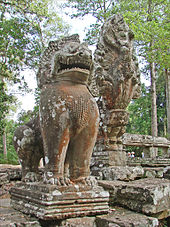
In Cambodia statues of lions flanking the temple gate or access roads are commonly found in temples of Angkor. Bakong, a stepped pyramid Hindu temple from earlier period also displays lion statues as guardians of each stage on each of the cardinal points. Khmer lion guardian statues are commonly found in Angkor Wat, Bayon, Pre Rup and Srah Srang. Just like ancient Java, the depiction of lion in ancient Khmer art is not in naturalistic style, more like a symbolic mythical animal derived from Indian Hindu-Buddhist art. The royal emblem of Cambodia depicting a pair of guardian animals; gajasingha (hybrid of elephant and lion) and singha (lion). In Thailand, a pair of lion statues are often placed in front of temple gate as guardian. The style of Thai lion is similar to those of Cambodian, since Thailand derived many of its aesthetics and arts elements from Cambodian Khmer art.[citation needed]
In
The island nation of Singapore (Singapura) derives its name from the Malay words singa (lion) and pura (city), which in turn is from the Tamil-Sanskrit சிங்க singa सिंह siṃha and पुर புர pura.[57] According to the Malay Annals, this name was given by a fourteenth-century Sumatran Malay prince named Sang Nila Utama, who, on alighting the island after a thunderstorm, spotted an auspicious beast on shore that his chief minister identified as a lion (Asiatic lion).[58] Recent studies of Singapore indicate that lions have never lived there.
In the modern era, the lion or
China and Tibet

The common motif of the "majestic and powerful" lion was introduced to China by Buddhist missionaries from India, somewhere in the first century AD.[59] Lions themselves, however, are not native to China, yet appear in the art of China and the Chinese people believe that lions protect humans from evil spirits, hence the Chinese New Year lion dance to scare away demons and ghosts. Chinese guardian lions are frequently used in sculpture in traditional Chinese architecture. For instance, in the Forbidden City in Beijing, two lion statues are seen in almost every door entrance.
Lions feature prominently in the Tibetan culture with a pair of
Japan
The lion became popular in Japanese art from the 14th century onwards, under Chinese influence. The Chinese artistic form of the "dog-lion" (kara-shishi in Japanese) was almost always used, but was generally somewhat fatter, and with a shorter torso, than in China, with a short fan-like tail and a flattened face.[60] Hokusai had a "special cult of the Chinese lion, whose "spiritual form" he drew each morning".[61]
Lions (獅子,
In narration
The lion appears in several fairy and folk tale traditions all over the world. Some tale types, according to the
- Aarne-Thompson-Uther type number 156, "
- Aarne-Thompson-Uther type number 300, "The Dragon-Slayer": in some variants, a lion appears as part of the hero's animal entourage to defeat a vicious dragon and rescue the princess.[64]
- Aarne-Thompson-Uther type number 303, "The Twins or Blood-Brothers": this tale type sometimes merges with the previous one. Twins (or triplets) or lookalike individuals acquire two sets of fierce animals, like bears, lions and wolves. Each goes their separate ways: one defeats the dragon and the other meets a witch who petrifies his twin. Example: The Three Princes and their Beasts, Lithuanian fairy tale; The Two Brothers, German fairy tale by the Brothers Grimm.[65]
- Aarne-Thompson-Uther type number 425, "The Search for the Lost Husband", and Aarne-Thompson-Uther type number 425A, "Animal as Bridegroom": a maiden is betrothed to an animal bridegroom (a lion, in several variants), who comes at night to the bridal bed in human form. The maiden breaks a taboo and her enchanted husband disappears. She is forced to seek him.[66] Example: The Singing, Springing Lark, a German fairy tale by the Brothers Grimm;[67] La fiancée du lion ("The Lion's Bride"), Breton folktale collected by Paul Sébillot.[68]
- Aarne-Thompson-Uther type number 552, "The Girls who married Animals": a bankrupt nobleman or a poor farmer is forced to wed his daughters to three animal suitors, who are actually enchanted princes under a curse. In some variants, one of the suitors is a lion. Example: The Three Enchanted Princes.[69][70][71][72][73]
- Aarne-Thompson-Uther type number 590, "The Faithless Mother" or "The Prince and the Arm Bands": a boy with his mother finds a magic belt (magic arm bands) that grants strength. Later, his mother conspires with her new paramour (giant or ogre) to kill her son. Two lions end up helping the youth.[74] Example: The Blue Belt, Norwegian fairy tale.
The lion also appears as a king's councillor in the German fairy tale The Twelve Huntsmen.[75]
The lion also appears as an obstacle in the hero's dangerous quest, such as a guardian of the water of life, of a garden or of a princess.[75][76][77]
Title of kings and political leaders
Various kings and political leaders in different cultures and times, famed for courage or fierceness, were entitled "the lion" – such as:
- Llywelyn the Great, along with his family, were known to bear lions on their arms
- Henry the Lion of Saxony
- Richard the Lionheart, first used a single lion, then the three-lion bearing that became the arms of the Plantagenet dynasty.
- Robert III, "The Lion of Flanders"
- Lala Lajpat Rai, "The Lion of Punjab"
- Arabic: أَسَـد الـصَّـحْـرَاء, "Lion of the Desert").[78]
- Sundiata Keita the "Lion of Mali".[79]
- The Al-Assad family, ruling in Syria, derives its surname from the title Asad ("lion" in Arabic) of an ancestor[80]
- Thirteen popes took the name Leo
- Maharaja Ranjit Singh, "Lion of the Punjab"[81]
In fine art
During the Renaissance, animals, especially those close to man, were depicted with passion but also with scientific rigor. However, exotic animals, which were difficult to observe, were in part imagined by the painter: La Chaste au tigre (The Tiger Hunt), a Baroque painting by Rubens depicting a hunt for big cats, including lions, is a work that was partly imagined by the painter; the composition of the picture, however, allowed realism to be breathed into these invented felines.[82] For Théophile Gautier, it was essentially "lions with wigs" that were produced during Classicism.[83]
The Romantic painter worked as much on anatomical accuracy, notably by practicing the representation of real subjects held in zoos, as on the desire to depict a sentimental animal, which drew the ridicule of classical-style artists. Lion and tiger enjoy renewed interest. The Romantic period was marked by a number of great paintings, such as Eugène Delacroix's lions.[83]
In the 19th century, numerous zoological illustrations by naturalists show the lion in particular. From the same period onwards, humorous and often irreverent depictions of the "king of animals" proliferated, particularly in political cartoons and comics.[citation needed]
Paintings
-
Allegory with a Virgin, 1479-80 by Hans Memling
-
Löwe by Albrecht Dürer, 1494
-
Hieronymus and the Lion, 1507 by Albrecht Altdorfer
-
Hercules fight with the Nemeean lion byPieter Paul Rubens
-
Samson's Fight with the Lion, by Lucas Cranach the Elder, 1525
-
Lion of the Atlas (French: Lion de l'Atlas) by Eugène Delacroix, 1829, in the Saint Louis Art Museum
-
The Christian Martyrs' Last Prayer by Jean-Léon Gérôme, 1863
-
Una and the Lion by Briton Rivière, 1880
-
The King Drinks by Briton Rivière, 1881
-
Painting Venus and Anchises by William Blake Richmond (1889 or 90)
U.K.
- Nelson's Column (1843) in Trafalgar Square, London, UK, four lions sculpted by Edwin Landseer.
- The South Bank Lion, also in London. One of the first sculptures in Coade stone.
U.S.
- National Zoological Park, two 5,000 pound, reclining brass lions flank the Connecticut Avenue entrance,[84]
- Patience and Fortitude, the two Tennessee marble lions flanking the main entrance to the New York Public Library Main Branch, in Manhattan; sculpted by Edward Clark Potter
- House of Cards[85]
- the Rosicrucian Fellowship Temple Historic District and is also a local landmark in Oceanside, California. Cast concrete lions stand guard at each end of the arch.[86][87]
In heraldry


with significantly inaccurate anatomy
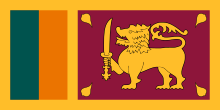
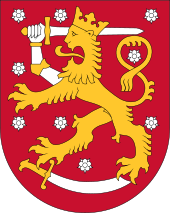
The lion is a common charge in heraldry, traditionally symbolizing courage.[88] The following positions of heraldic lions are recognized:[89]
- rampant
- guardant
- reguardant
- passant
- statant
- couchant
- salient
- sejant
- dormant
The lion holds historical significance for English heraldry and symbolism. The
The
- Lions in heraldry
-
Royal insignia of Cambodia with gajasingha and singha lions
-
A heraldic lion 'dormant'
-
Coat of arms of the Kingdom of Iraq (1932–1959), depicting the lion and horse
Currency
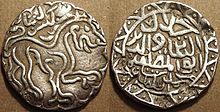
National currencies of three countries in Europe are named after the lion: the Bulgarian lev (Bulgarian: лев, plural: лева, левове / leva, levove), and the Moldovan and Romanian leu (/leŭ/, plural: lei /lej/) all mean "lion".
A lion appears on the South African 50-rand banknotes.
Names
Ship names
No fewer than 18 consecutive ships of the British Royal Navy bore the name HMS Lion. Various other navies have also used the name for their vessels,[citation needed] as have civil shipping companies.[citation needed]
Place names
- Singapore's name is the Anglicised form of the original Sanskrit-derived Malay name Singapura, which means 'Lion City'. Malay mythology describes how the founder-prince of Singapore (then called 'Temasek') sighted a strange red and black beast with a mane when he first set ashore the island. Believing it to be a lion and a good omen (although lions were not known to exist anywhere in Southeast Asia) he renamed the island Singapura. The lion features on the Singapore national coat of arms and is also the nickname of the national football team. 'Lion City' is also a common moniker for the city-state.
- Many places in India and greater South Asia use "Singh" in their names
- Using Leon (lion) as a placename started in Greek colony in Sicily.
- name meaning "lion". The Latin name for Lviv is Leopolis, meaning "Lion City".
- The name of the city of Tahert and Souk Ahras. The name is attested in multiple Berber languages, for instance as uharu and ahra. A popular Oran legend tells that in the period around 900 BC, there were sightings of lions in the area. The two last felines were killed in a mountain near the city of Oran, which is now known as La montagne des Lions ("The Mountain of Lions"). In fact, there are two giant lion statues in front of Oran's city hall, hence the twin lions' mountain is Oran's symbol.
- Despite common misconception, the name of the French city of armes parlant.


Given names
- Lionel traces its etymology from Latin, and means "little lion".
- Leo means "lion".
- Leonard means "lion strength", "lion-strong", or "lion-hearted".
Modern culture
Literature
- In Thus Spoke Zarathustra by Friedrich Nietzsche, the lion is used as a metaphor to describe a human who rebels against old knowledge, to make a new morality possible. The morality of the overman.
- The lion's symbolism continues in fantasy literature. J.K. Rowling's Harry Potterseries.
- Lafcadio: The Lion Who Shot Back is a 1963 children's book written and illustrated by Shel Silverstein. Lions also tend to appear in several children's stories, being depicted as "the king of the jungle".
- In award-winning children's picture book, Charlie and Mama Kyna, Leo, the lion, befriends and journeys home with Charlie in vivid illustrations.
- In the A Song of Ice and Fire series by George R. R. Martin, one of the main noble houses and main antagonists of the series, the Lannisters, have a golden lion on crimson as their family symbol, and in contrast to the lion being presented as a regal, noble creature in traditional folklore, it carries the undertones of pride, corruption, and lust for power of the Lannisters.
- Again adhering to king of the beast role, the book dewclawsas opposed to lions who's declaws are more stationary. They also live longer and speak varied languages.
- The Pride of Baghdad is based on a real story of African lions that escaped from Baghdad Zoo in 2003.[93]
Film

The lion's role as "king of the beasts" has been utilized in a number of cartoons, from the Leonardo Lion of King Leonardo and His Short Subjects (1960–1963) series to the Disney animated feature film The Lion King (1994). Metro-Goldwyn-Mayer studios have used a lion as their logo since 1924. At least seven different lions have played Leo the Lion, the lion seen at the start of every MGM film.[94]
- The Elsa, and the efforts of Joy Adamson and her game-warden husband Georgeto train Elsa for release back into the wild.
- Roar (1981) features numerous untrained lions, three of which were credited as actors. The lions did as they pleased on-set, so they also share writing and directing credits.[95]
- The Ghost and the Darkness (1996) is a movie set in 1898. It is based on the true story of two lions in Africa that killed 130 people over a nine-month period, during the construction of a railroad bridge across the Tsavo River, in what is now Kenya. The local natives named the two lions, both males, "The Ghost" and "The Darkness".[96]
- In 2005, the Kenyan lioness Kamuniak captured international attention when she adopted oryx calves, an animal species normally preyed upon by lions. She fought off predators and lion prides who attempted to eat her charges. Kamuniak's story was captured in the Animal Planet special Heart of a Lioness.[97]
Modern symbolism
The lion is a popular mascot or symbol, for businesses, government entities, sports, and other uses; for example:
Automotive brands
- Some Ford XL.
- A modified heraldic lion is the emblem of Australian car company Holden, an iconic Australian brand.[98]
- Peugeot has as symbol a lion in heraldic style, a French mark
- INKAS, Büssing, MAN AG, Proton, Roewe all feature lions in their branding for their automobiles
Government entities
- Patience and Fortitude, the large stone lions outside the main branch of the New York Public Library, are the mascots of the New York Public Library system serving the Bronx, Manhattan, and Staten Island.
- The Flag of Iran bore the Lion and Sun from 1576 to 1979.[99]
- In Brazil, the lion is a popular symbol of the income tax.[citation needed]
Political parties
- Shiromani Akali Dal (Amritsar) (political party in India) uses a Khanda, flanked by 2 lions as its emblem.[100]
Sports
- The 1966 FIFA World Cup and the 2006 FIFA World Cup both used lions as their mascot.
- Turkish major football club Galatasaray SK has been symbolized by a lion since the 1930s.
- The Detroit Lions of the National Football League have featured a lion in their logo since 1934.
- IPL teams Chennai Super Kings, Punjab Kings, Rajasthan Royals, Royal Challengers Bangalore, and the Gujarat Lions all used lions in their logos.
- MMA fighter Amanda Nunes uses the ring name "The Lioness"[101][102][103]
See also
- Lion-baiting
- Winged lion
- Piraeus Lion
- Medici lions
- Manticore (mythical part-lion beast)
- Khoekhoe Lion Story
- Lion of Amphipolis
- Lion of Venice
References
- ^ Chauvet, J.-M.; Brunel, D. E.; Hillaire, C. (1996). Dawn of Art: The Chauvet Cave. The oldest known paintings in the world. New York: Harry N. Abrams.
- ^ Züchner, Christian (1998). Grotte Chauvet Archaeologically Dated. International Rock Art Congress. Vila Real, Portugal. Archived from the original on 21 February 2001. Retrieved 27 August 2007.
- .
- Abu Dhabi Department of Culture & Tourism. 2017. p. 52. Retrieved 9 March 2019.
- ^ ISBN 978-0-671-21773-0.
- .
- ISBN 9780500050965.
- ISBN 978-0951397763.
- ISBN 978-0-19-953836-2.
- ^ "Iraq secure much-needed win over rivals Iran in friendly" (PDF). Iraqi-Football.com. 18 March 2017.
- ISBN 9780714120201.
- ^ "The Art Institute of Chicago" Archived 19 August 2007 at the Wayback Machine. The Chicago Traveller. 2007
- ^ a b "The Hidden Language of Anatolia". Skylife Magazine, 2001
- ^ "Iraqi Multi-National Force & Corps Logos, Ancient Assyro-Babylonian Images". Zinda Magazine, 2004.
- ^ Matthews, Kevin (2007). Lion Gate. Great Buildings Online.
- ^ Gesché‐Koning, N. & Van Deuren, G. (1993). Iran. Bruxelles, Belgium: Musées Royaux D'Art et D'Histoire.
- .
- ^ "Ancient Persian Art". visual-arts-cork.com.
- ^ Douglas, N. (1927). Birds and Beasts of Greek Anthology. Florence: Norman Douglas.[page needed]
- JSTOR 4493342.
- .
- ISBN 978-0-5217-6904-4.
- ^ Uhm, D.P. van (2016). The Illegal Wildlife Trade: Inside the World of Poachers, Smugglers and Traders. Switzerland: Springer International Publishing.[page needed]
- ^ Thomas, N.R. 2014: A lion's eye view of the Greek Bronze Age. Annales liégeoises et PASPiennes d’archéologie égéenne. 11–14 décembre 2012. 375–392.
- ISBN 0876615337.
- ISBN 0-14-001026-2.
- ^ Hagigah 13b.[full citation needed]
- ^ Virgil. "Book V, Line 352". Aeneid.
..my task to offer consolation to our friend for the downfall he did nothing to deserve." With these words he gave Salius the hide of a huge Gaetulian lion, weighed down with gilded claws and mane.
- ^ Horace. "Book I, Ode XXIII". Odes of Horace.
You shun me, Chloe, like a fawn that is seeking its timorous mother in the pathless mountains, not without a vain dread of the breezes and the thickets: for she trembles both in her heart and knees, whether the arrival of the spring has terrified by its rustling leaves, or the green lizards have stirred the bush. But I do not follow you, like a savage tigress, or a Gaetulian lion, to tear you to pieces. Therefore, quit your mother, now that you are mature for a husband.
- ^ Pliny the Elder. "Book VIII – Chapter: Wonderful feats performed by lions". Natural History.
It was formerly a very difficult matter to catch the lion, and it was mostly done by means of pit-falls. In the reign however, of the Emperor Claudius, accident disclosed a method which appears most disgraceful to the name of such an animal; a Gaetulian shepherd stopped a lion, that was rushing furiously upon him, by merely throwing his cloak over the animal; a circumstance which afterwards afforded an exhibition in the arena of the Circus, when the frantic fury of the animal was paralyzed in a manner almost incredible by a light covering being thrown over its head, so much so, that it was put into chains without the least resistance; we must conclude, therefore, that all its strength lies in its eyes. The circumstance renders what was done by Lysimachus less wonderful, who strangled a lion, with which he had been shut up by command of Alexander.
- ^ Philostratus (215). Life of Apollonius of Tyana.
The extremity of Libya, which bears the name Abinna, furnishes a haunt of lions, who hunt their prey along the brows of the mountains which are to be seen rising inland, and it marches with the Gaetuli and Tingae, both of them wild Libyan tribes.
- ^ Robert Louis Stevenson (1879). Travels with a Donkey in the Cévennes.
"Your father and mother?" cried the priest. "Very well; you will convert them in their turn when you go home." I think I see my father's face! I would rather tackle the Gaetulian lion in his den than embark on such an enterprise against the family theologian.
- ^ "Plato, Republic 588A-589B". "The Gnostic Society Library. Retrieved 12 February 2009.
- OCLC 371079.
- ^ Wikisource:Bible (American Standard)/1 Peter#Chapter 5 Verse 8
- ISBN 0-271-01605-1. Retrieved 13 September 2010.
- JPS Tanakh[full citation needed]
- ISBN 9780567685148.
- ^ Hipp. Ref. vi. 9.[full citation needed]
- ^ Apocryphon of John[full citation needed]
- ISBN 978-90-04-03902-5.
- ProQuest 1299160146.
- ISBN 978-90-474-4453-4.
- OCLC 54843901.
- ^ "The Eighth Gate: The Mithraic Lion-Headed Figure and the Platonic World-Soul". mysterium.com.
- ISBN 9780190624552.
- ISBN 978-1-909686-86-1.
- ^ Pastor, G.A. "The lions from the maristán". Patronato de la Alhambra y Generalife. Retrieved 14 May 2022.
- ^ "The court of the lions". Patronato de la Alhambra y Generalife. Retrieved 14 May 2022.
- ^ JSTOR 20752481.
- ISBN 978-0-19-530991-1.
- ^ Badam, G. L. & Sathe, V. G. (1991). "Animal depictions in rock art and palaeoecology – a case study at Bhimbetka, Madhya Pradesh, India". In Pager, S. A.; Swatrz Jr., B. K. & Willcox, A. R. (eds.). Rock Art – The Way Ahead: South African Rock Art Research Association First International Conference Proceedings. Natal: Southern African Rock Art Research Association. pp. 196–208.
- ISBN 978-81-8475-277-9.
- ISBN 978-81-208-0557-6.
- OCLC 830270907.
- ISBN 978-81-7023-139-4.
- ^ "Singapore". bartleby.com. Archived from the original on 29 June 2008. Retrieved 14 April 2006.
- ^ "Early History". Ministry of Information, Communications and the Arts, Singapore. Archived from the original on 27 April 2006. Retrieved 14 April 2006.
- ^ B. N. Goswamy (6 October 2002). "Celebrating with the Lion Dance". tribuneindia.com.
- ^ von Krenner & Jeremiah, 78
- ^ von Krenner & Jeremiah, 81
- ^ Aarne, A.; Thompson, S. (1961). The types of the folktale: a classification and bibliography. Helsinki: Folklore Fellows Communications FFC no. 184. Academia Scientiarum Fennica.
- ISBN 978-3-11-019441-8.[page needed]
- ^ Theuerkauf, Marie-Luise (2014). "Essay - Dragon Slayers and Lion Friends: Intertextual Considerations in Tochmarc Emire". Aigne Journal. 5.
- ISBN 978-3-11-019441-8.
- ISBN 978-3-11-019441-8.
- Project MUSE book 65930.
- ^ Sébillot, Paul. Contes des landes et des grèves. Hyacinthe Caillière Editeur, Rennes, 1900. pp. 117–127. [1]
- ^ von Hahn, Johann Georg. Griechische und Albanesische Märchen 1–2. München/Berlin: Georg Müller. 1918 [1864]. pp. 139–145 and 363.
- ^ Kretschmer, Paul. Neugriechische Märchen. 1919. pp. 77–84.
- ^ Hoogasian-Villa, Susie. 100 Armenian Tales and Their Folkloristic Relevance. Detroit: Wayne State University Press. 1966. pp. 440–441.
- ^ Kunos, Ignacz. Forty-four Turkish fairy tales. London: G. Harrap. [undated] pp. 102–116.
- ^ Fansler, Dean Spouill. Filipino Popular Tales. The American folk-lore society. 1921. pp. 171–178.
- ^ Aarne, A.; Thompson, S. (1961). The types of the folktale: a classification and bibliography. Helsinki: Folklore Fellows Communications FFC no. 184. Academia Scientiarum Fennica. pp. 215–217.
- ^ JSTOR j.ctv6p4w6.8.
- ISBN 1-85109-640-X.
- ISBN 978-1-315-09712-1.
- ISBN 978-1874263647.)
{{cite book}}: CS1 maint: location missing publisher (link - ISBN 978-0-8160-4892-2.
- ISBN 9780520069763.
- ^ "Ranjit Singh Sikh maharaja". Encyclopædia Britannica. Retrieved 8 August 2022.
- ^ "Rubens, Pierre Paul, la Chasse au tigre". Larousse.fr (in French). Retrieved 6 August 2009.
- ^ a b Brion, Marcel (1995). Les animaux, un grand thème de l'Art (in French). Paris: Horizons de France.
- ^ "Bronze Lions Flank Connecticut Avenue Entrance". National Zoo. Archived from the original on 2 April 2015. Retrieved 4 March 2015.
- ^ Willimon, Beau; et al. (20 February 2014). "History Behind Lion Statues House of Cards Opening Credits". Ghosts of DC.
- ^ "Main Entrance of Mount Ecclesia (Lions Arch)".
- ^ "Lions Arch at Mt. Ecclesia: photo by Robert Sommers, 2015".
- ISBN 978-0-7661-4168-1.
- ^ Heraldic Dictionary: Beasts. University of Notre Dame. Archived from the original on 10 June 2007. Retrieved 20 July 2007.
- ^ ISBN 1-85326-334-6.
- ISBN 0-517-50086-8
- ISBN 0-06-023481-4.
- ^ Richards, D. (2006). "The Joy of Pride: Vaughan talks "Pride of Baghdad"". Comic Book Resources. Archived from the original on 23 December 2013. Retrieved 10 May 2013.
- ^ "TV ACRES: Advertising Mascots – Animals – Leo the MGM Lion (MGM Studios)". TV Acres. Archived from the original on 5 December 2012. Retrieved 6 August 2007.
- ^ Donovan, Sean (20 March 2019). "Animalistic Laughter: Camping Anthropomorphism in Roar". CineFiles. Retrieved 11 September 2019.
- ^ "The Ghost and the Darkness Were Their Names | Maneless Man-e… | Flickr". 4 April 2007.
- ^ "Wild Kingdom Schedule Fallback". Animal Planet. 25 September 2014.
- ISBN 0-9577000-0-8.
- ^ Shahbazi, A. Shapur (2001). "Flags". Encyclopedia Iranica. Vol. 10. Costa Mesa: Mazda. Archived from the original on 17 August 2007. Retrieved 6 August 2007.
- ^ "SADA – Shromani Akalidal Amritsar Official Website".
- ^ "Amanda Nunes". UFC. 30 July 2022. Retrieved 6 August 2022.
- ^ "Amanda Nunes". UFC Stats. 30 July 2022. Retrieved 9 August 2022.
- ^ "Amanda Nunes ("The Lioness") | MMA Fighter Page". Tapology. 30 July 2022. Retrieved 9 August 2022.
- von Krenner, Walther G., Jeremiah, Ken, Creatures Real and Imaginary in Chinese and Japanese Art: An Identification Guide, 2015, McFarland, ISBN 9780786497287, google books







